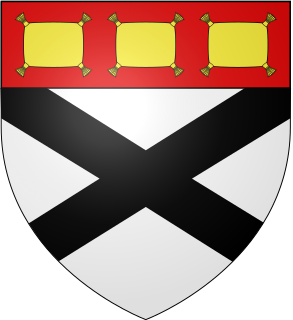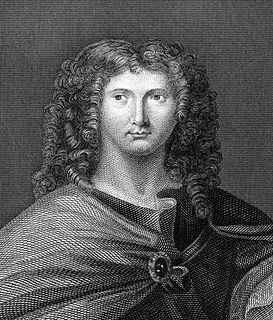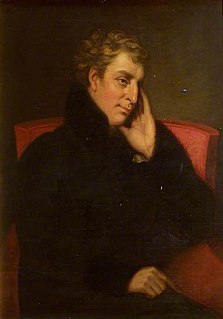Related Research Articles

Earl of Cork is a title in the Peerage of Ireland, held in conjunction with the Earldom of Orrery since 1753. It was created in 1620 for Richard Boyle, 1st Baron Boyle. He had already been created Lord Boyle, Baron of Youghal, in the County of Cork, in 1616, and was made Viscount of Dungarvan, in the County of Waterford, at the same time he was given the earldom. These titles are also in the Peerage of Ireland.

Earl of Crawford is one of the most ancient extant titles in Great Britain, having been created in the Peerage of Scotland for Sir David Lindsay in 1398. It is the premier earldom recorded on the Union Roll.

Earl of Annandale and Hartfell is a title in the Peerage of Scotland, created in 1661 for James Johnstone.

Earl of Kingston is a title in the Peerage of Ireland. It was created in 1768 for Edward King, 1st Viscount Kingston. The Earl holds the subsidiary titles Baron Kingston, of Rockingham in the County of Roscommon, Viscount Kingston, of Kingsborough in the County of Sligo, Baron Erris, of Boyle in the County of Roscommon, and Viscount Lorton, of Boyle in the County of Roscommon, also in the Peerage of Ireland. He is also a baronet in the Baronetage of Ireland. Between 1821 and 1869 the earls also held the title Baron Kingston, of Mitchelstown in the County of Cork, in the Peerage of the United Kingdom.
Earl of Clancarty is a title that has been created twice in the Peerage of Ireland.
The Earl of Tyrone is a title created three times in the Peerage of Ireland.

Earl of Roscommon was a title in the Peerage of Ireland. It was created on 5 August 1622 for James Dillon, 1st Baron Dillon. He had already been created Baron Dillon on 24 January 1619, also in the Peerage of Ireland. The fourth Earl was a courtier, poet and critic. The fifth Earl was a professional soldier, politician and courtier: he was friendly with Samuel Pepys, who refers to him several times as "Colonel Dillon" in his famous Diary. After the death of the tenth Earl, there were two prolonged investigations by the Irish House of Lords during the 1790s to ascertain the legitimacy of his son Patrick, against the rival claim by Robert Dillon, a descendant of the seventh son of the first Earl and the next male heir in line. These eventually found in Patrick's favour. The titles became dormant on the death of the eleventh Earl in 1816. However, in 1828 the United Kingdom House of Lords decided that the rightful heir to the peerages was Michael Dillon, another descendant of the seventh son of the first Earl, who became the twelfth Earl. The House of Lords decided against Francis Stephen Dillon, an inmate of a debtors' prison who dubiously claimed descent from the third son of the first Earl. The titles became extinct on the death of the twelfth Earl on 15 May 1850.

Wentworth Dillon, 4th Earl of Roscommon (1637–1685), was an Anglo-Irish landlord, Irish peer, and poet.
The title of Count of Tyrone has been used by two European branches of the O'Neill family to claim affiliation with the O'Neill Earls of Tyrone in the Peerage of Ireland. Romance languages, such as French, Spanish, and Portuguese, do not distinguish between earls and counts, but use the same word for both; when these titles have been translated into English, they are generally rendered Count.
David Fitz-James de Barry, 18th Baron Barry, 5th Viscount Buttevant (1550–1617), sided initially with fitz Maurice, the rebel, in the 1st Desmond rebellion but changed sides and fought against the rebels. He also fought for the crown in the Nine Years' War.

Theobald Dillon, 7th Viscount Dillon of Costello-Gallin supported King James II, was attainted on 11 May 1691, and fell in the Battle of Aughrim during the Williamite War. His attainder was reversed in favour of the 8th Viscount on 20 June 1694.

Charles Dillon-Lee, 12th Viscount Dillon, KP, PC (Ire) (1745–1813) conformed to the established religion in 1767.

Henry Augustus Dillon-Lee, 13th Viscount Dillon (1777–1832), was an Irish peer, soldier, writer, and MP for Harwich in England and County Mayo in Ireland. He wrote about Catholic emancipation in Ireland, about military subjects, and also published two historical novels.

Thomas Dillon, 4th Viscount DillonPC (Ire) (1615–1673) held his title for 42 years that saw Strafford's administration, the Irish Rebellion of 1641, the Irish Confederate Wars and the Cromwellian Conquest of Ireland. He was a royalist and supported Strafford and Ormond. He sided with the Confederates for a while but was a moderate who opposed Rinuccini, the papal nuncio. Lord Dillon fled the field of the Battle of Dungan's Hill (1647) and did not rescue Ormond at the Battle of Rathmines (1649). However, he defended Athlone successfully against Ireton in 1650.
Sir James Dillon, 3rd Earl of Roscommon was an Irish magnate and politician. He was born a Catholic but converted at a young age to the Church of Ireland. He supported Strafford during his term as governor of Ireland. In the Confederate Wars and the Cromwellian conquest he was a royalist. He died in 1649, but was nevertheless included as the fifth on the list of people that were excluded from pardon in Cromwell's 1652 Act of Settlement.
Randal William MacDonnell, 1st Marquess of Antrim was an Irish peer.
James Dillon, 1st Earl of Roscommon was an Irish peer.
Carey or Cary Dillon, 5th Earl of Roscommon, PC (Ire) (1627–1689) was an Irish nobleman and professional soldier of the seventeenth century. He held several court offices under King Charles II and his successor King James II. After the Glorious Revolution he joined the Williamite opposition to James and was in consequence attainted as a traitor by James II's Irish Parliament in 1689. In that year he fought at the Siege of Carrickfergus shortly before his death in November of that year.
Robert Dillon, 2nd Earl of RoscommonPC (Ire) was styled Baron Dillon of Kilkenny-West from 1622 to 1641 and became earl of Roscommon only a year before his death. He supported Strafford, Lord Deputy of Ireland, who appointed him as one of the keepers of the King's seal. Lord Kilkenny-West was in December 1640 for a short while a lord justice of Ireland together with Sir William Parsons.

Cormac MacDermot MacCarthy, 16th Lord of Muskerry (1552–1616) was an Irish magnate and soldier. He fought at the Siege of Kinsale during Tyrone's Rebellion.
References
- ↑ O'Hart, John (1892). Irish Pedigrees: Origin and Stem of the Irish Nation. Dublin: J Duffy. p. 410.
- ↑ MacDermotRoe, Ken. "ROSCOMMON PEERAGE TRIAL". MacDermot Roe, Biatach. Retrieved 26 March 2014.
- 1 2 "The Earl of Roscommon". Archived from the original on 30 August 2010.
- ↑ Taylor, J Syndey, ed. (1829). The Roscommon claim of peerage, explained by the speeches delivered before the Lords' committee of privileges. Fleet Street, London: Saunders and Benning.
- ↑ "Roscommon, Earl of (I, 1622 - 1850)". Archived from the original on 30 August 2010.
- ↑ "Person Page".